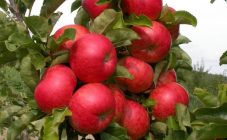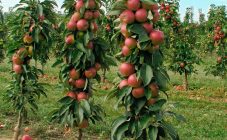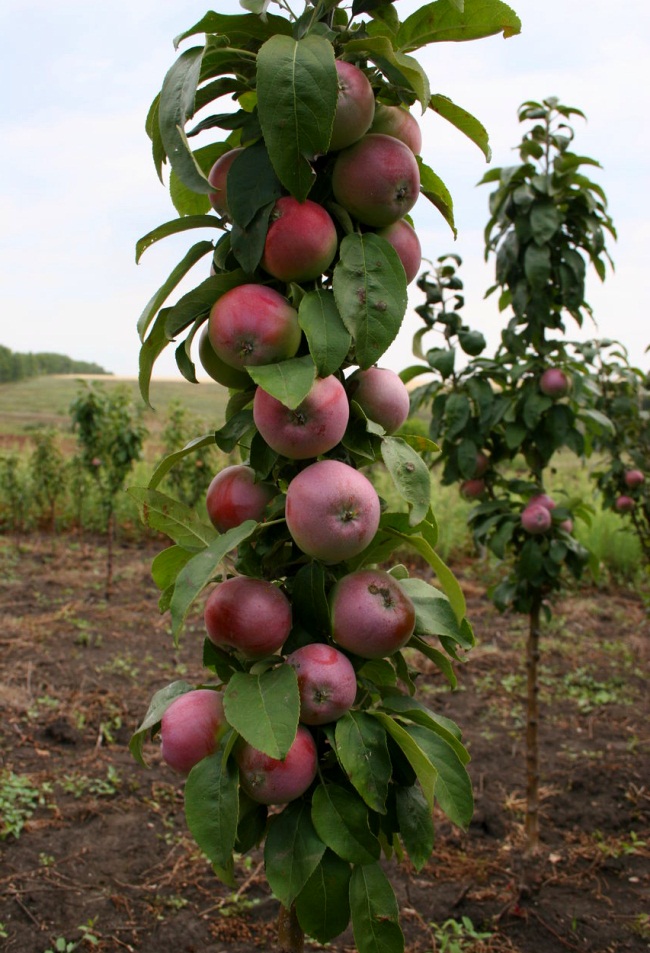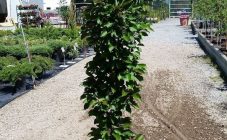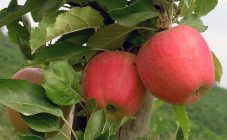Content:
Probably, you cannot find a gardener in whose garden an apple tree would not grow. This culture grows well in the Russian climate, requiring little maintenance. Recently, more and more gardeners are making a choice in favor of columnar varieties, for example, the columnar apple tree Amber Necklace.
general description
In terms of its varietal characteristics, the Amber Necklace is in many ways reminiscent of the columnar apple tree Pearl necklace and the apple tree Ruby necklace. Some experts even consider the listed varieties to be variants of the same variety. The difference between cultures lies only in the color of the fruits and in some of the not-so-significant traits.
The variety gained recognition almost immediately after its appearance. Until now, it is in rather high demand among domestic gardeners. This columnar variety will not only become a real decoration of the apple orchard, but will also give an excellent harvest at the end of the season.
Characteristics of the variety
The amber necklace apple-tree columnar is a fairly compact tree with a crown diameter of no more than 40 cm, which can grow up to a height of 2.5 meters. On average, one healthy adult tree can harvest about 15 kg of apples per season. This apple variety blooms in May with large white flowers.
Like the apple tree Ruby necklace columnar, Amber necklace is a self-fertile variety. To obtain a harvest, you will need to plant other varieties of apple trees in the garden that have a similar flowering period. If there is no pollinator, there will be no harvest.
The technical ripening of this variety occurs in September. During storage, the fruits only improve their taste characteristics in 1-2 months. So the Amber Necklace is a great option for those wishing to have the opportunity to eat a fresh apple in winter.
Upon reaching maturity, the apples do not crumble from the trees, they only become softer and sweeter. So you can leave them in the garden for almost the entire autumn period, if necessary. The most important thing is to have time to harvest the crop before the frost sets in.
The apples are arranged very compactly and evenly on the tree. Their weight ranges from 240 to 180 grams. The pulp of the fruit is white and very juicy, with a pleasant sweet and sour taste. The fruits themselves have an excellent presentation, dense, but at the same time thin skin and tolerate storage and transportation well. If you create optimal conditions during storage, the apples will lie quietly until the end of spring.
Fruiting in a columnar apple tree Amber necklace usually begins from the second year after planting. But experts recommend to postpone and cut off all flowers in the second year of the plant's life. Otherwise, the plant will be greatly weakened. From next year, it is allowed to leave no more than a dozen ovaries for a couple of years. But in the fifth year of apple growth from the tree, it will be possible to collect at least 10 kg of selected apples.In another couple of years, this figure will increase by at least half.
The following interesting characteristic is inherent in the variety - the apple tree just perfectly resists fungal diseases. This is due to the columnar structure of the plant. Thickening and shading of the crown does not occur, the humidity does not increase due to the abundance of branches and shoots, and for the fungus, not the most comfortable conditions are simply created in terms of development and distribution.
In addition, the Amber Necklace rarely gets sick with scab and powdery mildew. Other diseases, unfortunately, are quite possible. First of all, the variety is prone to infestation with mosaics, spotting, cancer and rust.
Features of agricultural technology
Experts strongly recommend planting this type of apple tree in the spring before the buds open. If there is a desire, planting work can be carried out in the fall, the most important thing is that planting is carried out in good weather, after leaf fall, but before the start of frost in about 2 weeks.
Annual seedlings are best suited for planting. They quickly take root and begin to grow almost immediately. When choosing a seedling, close attention should be paid to its root system. It should be well developed enough, the presence of rot on the roots is unacceptable. Trees in which the roots are even a little dried are also not worth purchasing. Perhaps the seedling will come to its senses and take root, but it will take more time.
The ideal option is a seedling in a container. It can be transplanted at any warm season.
The area for planting an apple tree should be chosen open and sunny. At the same time, it is important to ensure the protection of the plant from strong gusts of wind and drafts.
Any soil is suitable for fertile and well-permeable water. Groundwater should not run higher than two meters.
For a columnar apple tree to be healthy and produce a good harvest, it must be properly cared for. Only in this case will a bright and original variety show itself in all its glory. What is especially important, all agricultural activities carried out should be of a systemic nature.
The nature of watering should be drip. Sprinkling is also acceptable. In hot summer, the soil under the crop should be moistened on average 2-3 times a week.
Top dressing is done three times per season. The first time the apple tree is fertilized at the end of April with urea, the second - before flowering with liquid cow dung, and the third - during the development of the ovaries with the help of ash. Usually, this amount of dressings is quite enough to get a decent result.
Advantages and disadvantages
Giving a description of the apple tree columnar Amber necklace, one cannot fail to mention its main advantages:
- compactness of trees;
- early maturity;
- regular and high yields;
- great fruit taste;
- good marketable appearance;
- long shelf life;
- excellent transportability;
- frost resistance (can be grown even in the Urals and Siberia);
- resistance to scab and fungi.
In general, the culture does not require much maintenance. Even not the most experienced gardener will be able to grow it.





